Question
The wild Bactrian camel, Camelus ferus, lives only in the desert regions of Mongolia and northern China.
Fig. 1.1 shows a wild Bactrian camel.
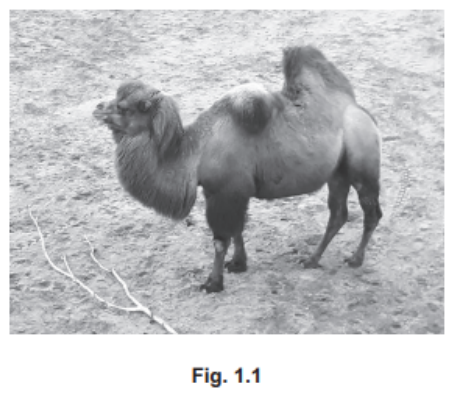
(a) The wild Bactrian camel is at risk of extinction in the wild and is categorised as critically endangered by the International Union for Conservation of Nature (IUCN). There are only 950 wild Bactrian camels left in their natural habitat.
Suggest reasons why the wild Bactrian camel has become critically endangered.[2]
(b) Outline the role of the IUCN. [3]
(c) Some zoos use assisted reproduction techniques, such as embryo transfer, in their captive breeding programmes for endangered species. Embryo transfer has resulted in domesticated dromedary camels giving birth to wild Bactrian camel calves.
Describe the procedure of embryo transfer in a mammal such as a camel.[4]
▶️Answer/Explanation
Ans:
1(a) any two from:[2]
1 habitat loss ;
2 competition with / disease from, farm / invasive / alien, animals / species ;
3 climate change ;
4 hunting/poaching/ killing by humans ;
5 AVP ;
1(b) any three from:[3]
1 global / international / worldwide (authority / advisory) ;
2 (to give advice to) conserve / protect, nature / biodiversity / habitats ;
3 assess / categorise, species conservation status ;
4 ref. Red List (of Threatened Species) ;
5 influence, governments / policy ;
6 educate / raise awareness ;
7 AVP;
1(c) any four from:[4]
1 mating / IVF / (super-ovulate female plus) Al ;
2 remove embryo (from, mated/artificially inseminated, female) ;
3 check/select, healthy/normal/best, embryos ;
4 may freeze embryos for, storage / later use ;
5 implant embryos in (different female) uterus ;
6 ref. surrogate (mother);
7 ref. (named female reproductive) hormone(s) ;
8 AVP ;
Question 2
2 (a) All organisms respire. The ATP produced as a result of respiration is used as the energy currency of the cell.
(i) Outline two examples of movement in cells that use ATP. [2]
(ii) ATP cannot be stored in cells so it has to be continually re-synthesised to meet the demands of an organism.
A person with a total quantity of 0.2 moles of ATP needs to hydrolyse 150 moles of ATP per day.
Calculate how many times the total quantity of 0.2 moles of ATP has to be re-synthesised per hour to meet the demand of 150 moles per day.
Show your working and give your answer to the nearest whole number.[2]
(iii) Name the stages in which chemiosmosis occurs in respiration and in photosynthesis.
respiration……………………………………………………
photosynthesis…………………………………………….. [2]
(b) Fur seals are mammals that are adapted to live in cold temperatures. Fur seals have large quantities of a type of fat tissue known as brown adipose tissue. Brown adipose cells contain many mitochondria. These mitochondria contain a transport protein called thermogenin.
Fig. 2.1 shows the role of thermogenin in a mitochondrion of a brown adipose cell when external temperatures are cold.
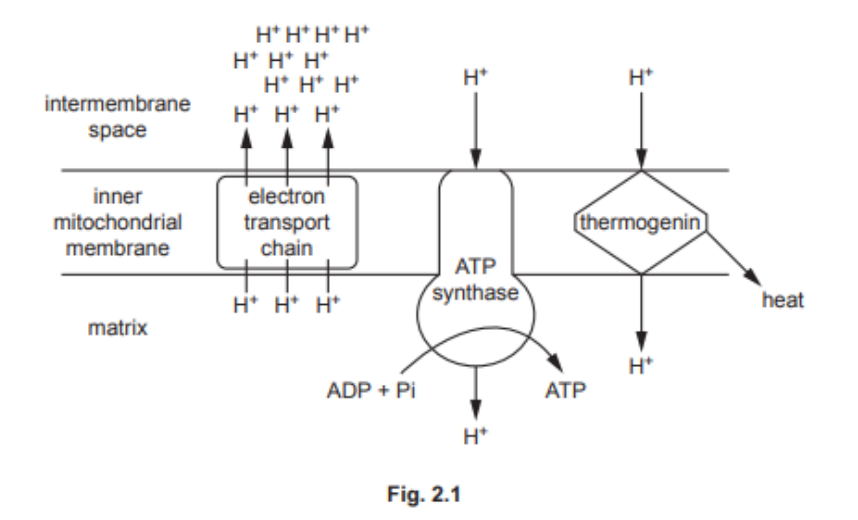
(i) With reference to Fig. 2.1, describe and explain the effect of thermogenin on ATP synthesis.[3]
(ii) When the external temperature is warm, thermogenin cannot function.
When the external temperature becomes cold, thermogenin is able to function as a result of cell signalling:
- adrenaline is released
- adrenaline acts on brown adipose cells
- a sequence of events is triggered that results in the activation of the enzyme
lipase
- lipase hydrolyses triglycerides in the cells into fatty acids
- fatty acids enter the mitochondrion
- thermogenin starts to function.
Outline the stages of cell signalling that trigger the functioning of thermogenin.[3]
▶️Answer/Explanation
Ans:
2(a)(i) any two from:[2]
1 ref. to muscle fibre / sarcomere, contraction ;
2 active transport of (named), ion / molecule
or
active transport (of substance) against concentration gradient ;
3 movement of, vesicles / organelles, through cytoplasm / described ;
4 exocytosis of named substance ;
5 endocytosis / phagocytosis ;
6 spindle fibre / chromosome / chromatid, (movement) during, mitosis / meiosis ;
7 cilia / flagella, wafting / beating / AW ; I movement
2(a)(ii) correct working; e.g. $\frac{150}{0.2}=750$ then $\frac{750}{24}$ [2]
or
$\frac{150}{24}=6.25$ then $\frac{6.25}{0.2}$
or
$
\frac{149.8}{0.2}=749 \text { then } \frac{749}{24}
$
31;
2(a)(iii) (respiration) oxidative phosphorylation ;[2]
(photosynthesis) photophosphorylation / light dependent stage ;
2(b)(i) $\quad 1$ reduces ATP synthesis / less ADP reacts with $P_i$;[3]
any two from:
2 protons diffuse through thermogenin ;
3 proton gradient reduced / reduces concentration of $\mathrm{H}^*$ in intermembrane space ;
4 fewer protons pass through ATP synthase ;
2(b)(ii) any three from:[3]
1 adrenaline binds to receptor on the cell surface membrane (of brown fat cells);
2 G-protein / adenyl(yl) cyclase, activated;
3 ref. to cAMP / second messenger, (is formed);
4 ref. to enzyme cascade / signal amplification / activation of kinase / signalling cascade ;
5 activation of lipase by phosphorylation ;
Question 3
3 DNA barcoding is used in species identification.
To create a DNA barcode, a specific region of DNA is sequenced so that it can be compared to an online database of reference DNA. One region of DNA that is commonly used is 648 base pairs long within a mitochondrial gene, coding for the enzyme cytochrome $c$ oxidase I.
(a) The solitary sandpiper, Tringa solitaria, is a migratory bird.
DNA barcoding has shown that approximately 2.5 million years ago $T$. solitaria evolved into two subspecies, Tringa solitaria solitaria and Tringa solitaria cinnamomea.
A subspecies is a genetically distinct population of a species that has some phenotypic differences but is not yet reproductively isolated.
T. s. solitaria breed in eastern North America whereas $T$. s. cinnamomea breed in western North America.
Suggest and explain how the two subspecies $T$. s. solitaria and $T$. s. cinnamomea could have evolved from the original $T$. solitaria population.
▶️Answer/Explanation
Ans:
3(a) any four from:[4]
1 geographic(al), isolation / barrier between populations ;
2 no/low / less, (inter)breeding/gene flow;
3 different mutations occur ;
4 different (named), selection pressures / environment(al conditions);
5 natural selection;
6 genetic drift ;
7 allopatric (sub)speciation ;
3(b) cytochrome c oxidase / (mitochondrial) gene / DNA / base, sequences,
(nearly) identical / (very) similar ;[2]
small number of bases different/low percentage difference ;
difference to other species is greater;
3(c) any two from:[2]
identify species, quickly / automatically / by non-experts ;
compare with, Red List / IUCN list / CITES appendix ;
confiscate / destroy / relocate, endangered species / ES products ;
prosecute / stop activities of, smugglers / traders / poachers ;
5 prevent entry of, predators / competitors / diseases, that could harm native ES ;
Question 4
Compound $\mathbf{F}$ has been found in small quantities in some cereals and dried fruit.
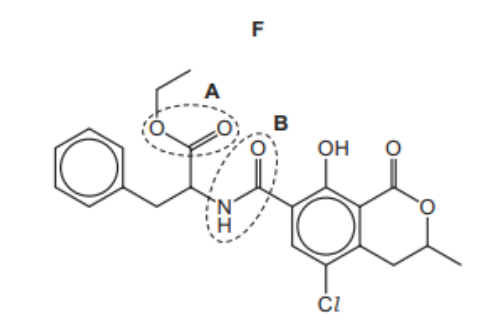
(a) (i) Give the name of the functional groups labelled A and B.
A…………………………………………………………………..
B…………………………………………………………………..[2]
(ii) State the number of chiral carbon atoms in one molecule of $\mathbf{F}$. [1]
(b) $\mathrm{F}$ can be hydrolysed by heating with an excess of dilute hydrochloric acid, as shown.
Three products are formed: $\mathbf{G}$ and two others.
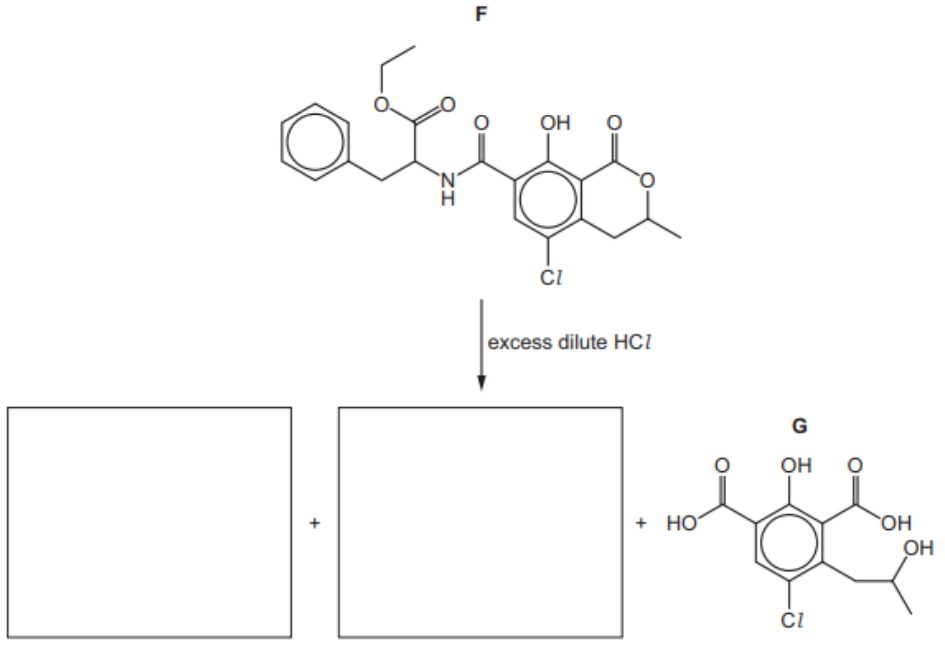
Draw the structures of the other products of the reaction in the boxes provided. [3]
(c) Compound $\mathbf{H}$ is formed in one step of a different synthesis, as shown.

(i) State the role of $\mathrm{FeCl}_3$ in this step.[1]
(ii) Use the Data Booklet to suggest two reasons why the chlorine atom in compound $\mathbf{H}$ substitutes into the ring at the position shown, instead of the other positions in the ring.[2]
(d) Compound $\mathrm{J}, \mathrm{C}_x \mathrm{H}_y \mathrm{O}_2$, is also found in some cereals.
Part of the mass spectrum of $\mathrm{J}$ is shown. The $M$ and $M+1$ peaks are labelled, along with their relative intensities.
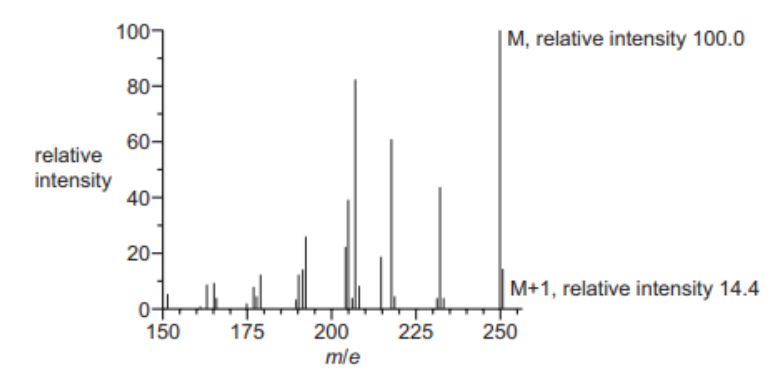
(i) Calculate the number of carbon atoms, $x$, present in $\mathbf{J}$.[2]
(ii) The mass spectrum has a peak at $m / e=205$.
Suggest the identity of the fragment lost from $\mathbf{J}$ to form this peak. [1]
▶️Answer/Explanation
Ans:
$4(a)(i)$
$\begin{aligned} & A=\text { ester } \\ & B=\left(2^{\circ}\right) \text { amide }\end{aligned}$ [2]
$4(a)(ii)$
2 [1]
4(b)
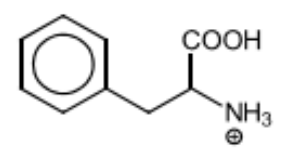
M1 phenylalanine [3]
M2 protonated amine
M3 (ethanol) $\mathrm{CH}_3 \mathrm{CH}_2 \mathrm{OH}$
4(c)(i) catalyst / halogen carrier [1]
4(c)(ii) $\quad$ M1 – OH directs to 2,4 AND both 2 positions occupied / only position 4 is available M2 – COOH directs to 3 position AND only position 3 is available / 5 is occupied [2]
4( d)
$
x=14.4 / 100 \times 100 / 1.1=13.1
$
13 carbon atoms (some working required) [1]
4 (d)(ii) $\quad\left(250-205=45\right.$, so) $\mathrm{CO}_2 \mathrm{H} / \mathrm{C}_2 \mathrm{H}_5 \mathrm{O}$ [1]
Question 5
Researchers investigated the extent to which the founder effect and natural selection affected evolutionary change.
Fig. 5.1 shows the brown anole lizard, Anolis sagrei. These lizards live on a number of Caribbean islands and feed on a variety of invertebrates and other small animals.
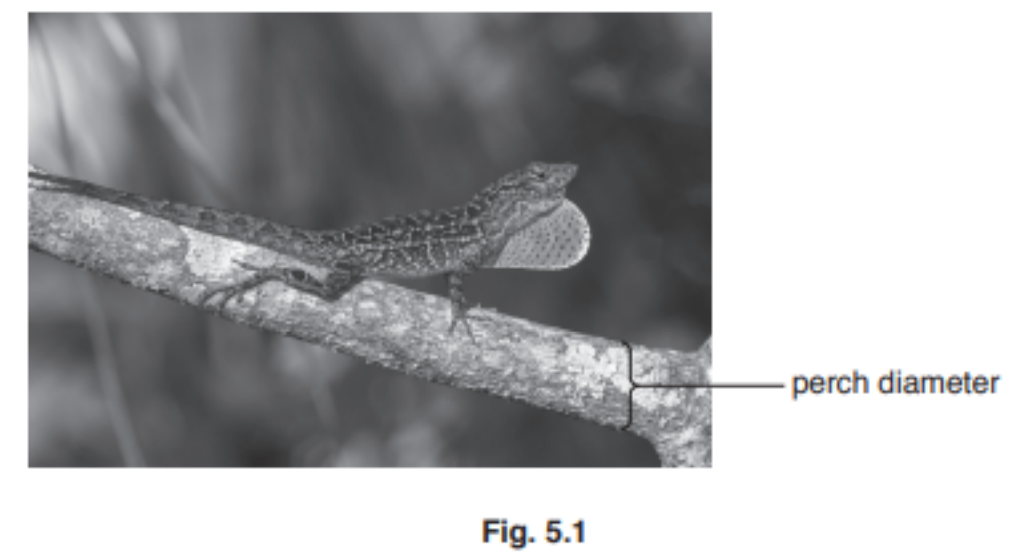
A. sagrei spends a lot of time perching (resting) on, or moving along, branches of shrubs and trees. The width of the branch that $A$. sagrei perches on is known as the perch diameter, as labelled in Fig. 5.1.
There is a positive correlation between perch diameter and hind limb length of $A$. sagrei.
- Longer hind limbs allow $A$. sagrei to run faster on vegetation with a larger diameter.
- Shorter hind limbs are needed to provide stability on vegetation of a smaller diameter.
In 2004, a hurricane caused the death of all the A. sagrei lizards on seven islands.
In 2005, the researchers randomly collected seven male and seven female lizards from a source population on a nearby island. For each of the seven islands affected by the hurricane, a male
and female lizard were mated and placed on each island. These islands formed the experimental founder islands where new populations of $A$. sagrei were successfully established from each founding pair.
Fig. 5.2 shows the difference in vegetation between the source island and the seven experimental founder islands.
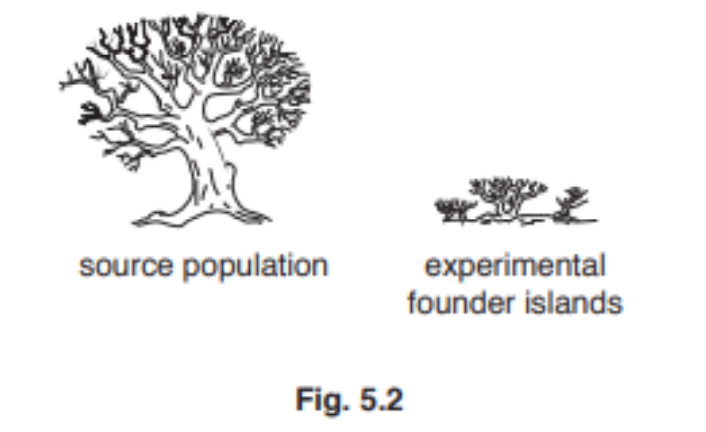
(a) (i) Predict the effect of natural selection on mean hind limb length of $A$. sagrei on the seven experimental founder islands. $[1]$
(ii) Predict how collecting individuals at random for the seven founding pairs affects the mean hind limb length of $A$. sagrei on the different islands. [1]
(b) Many generations of $A$. sagrei were produced over the four years after the introduction of the founding pairs.
Fig. 5.3 shows how the mean hind limb length of $A$. sagrei changed on the seven experimental islands and on the source island.
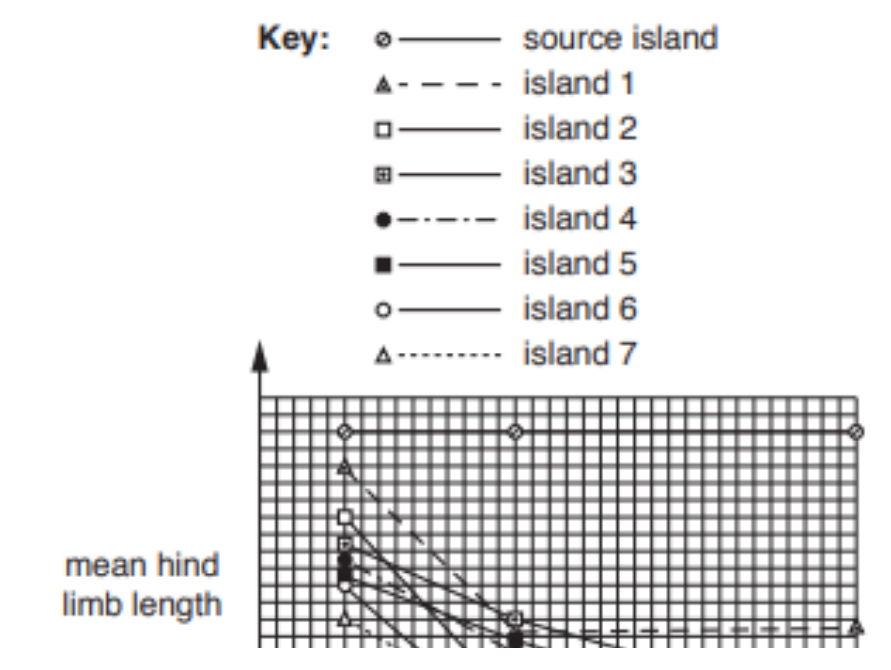
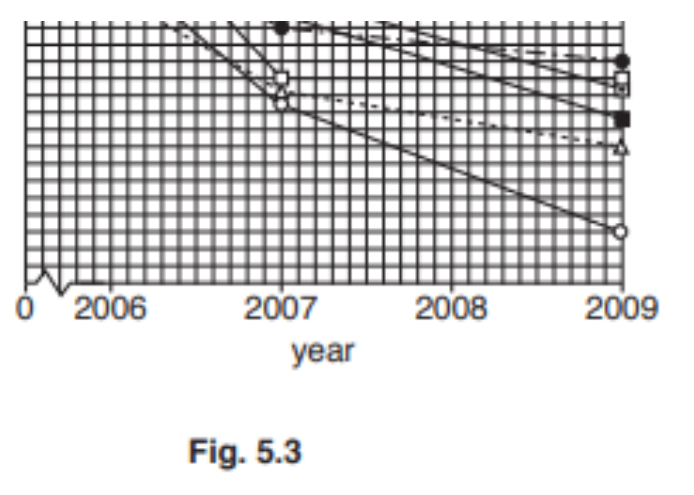
With reference to Fig. 5.2 and Fig. 5.3, describe and suggest explanations for the results for the islands. [5]
(c) In the investigation, one population of $A$. sagrei was established on each experimental founder island.
Outline how speciation may occur on the seven experimental founder islands.
Explain why the experimental founder populations are at high risk of extinction.[3]
▶️Answer/Explanation
Ans:
5(a)(i) (mean hind limb length) should decrease/legs get shorter ;[1]
5(a)(ii) $\quad$ (mean hind limb length) will vary ;[1]
5(b) any five from descriptions (D), suggestions (S) and explanations (E):[5]
D1 on, all / seven / the, experimental / founder, islands hind limb length decreased ;
S1 directional selection ;
D2 on source island hind limb length stayed the same ;
S2 stabilising selection;
explanation in context of experimental islands:
E1 selection pressure is, (reduced/thinner) perch / branch, (diameter);
E2 short (hind) limbs are, a selective advantage / selected for,
on, experimental islands / founder islands / thin branches ;
E3 (short hind limbs) allow / increase, stability/survival ;
E4 (survivors), reproduce / breed / pass on allele(s) (for short hind limbs);
E5 allele(s) for short (hind) limbs increases in frequency;
5(c) any three from:
allopatric ;[3]
populations / lizards / A. sagrei, on different islands, geographically / geologically, isolated / separated ;
have different, selection pressures / environmental conditions ;
different mutations occur ;
genetic drift ;
no gene flow / reproductive isolation, between, lizards on different islands / populations / (new) species ;
genetic differences accumulate ;
5(d) any three from:[3]
(each island has a) small population ;
with, low genetic diversity/small gene pool ;
inbreeding depression / low heterozygosity / high homozygosity ;
environmental change / natural disaster, may, kill them all/ make (whole / each) population extinct ;
Question 6
(a) The lac operon is a section of DNA present in the genome of Escherichia coli. The structural genes of the lac operon are only fully expressed when the bacteria are exposed to high lactose concentrations.
Fig. 6.1 is a diagram showing the lac operon and a nearby region of the $E$. coli genome.
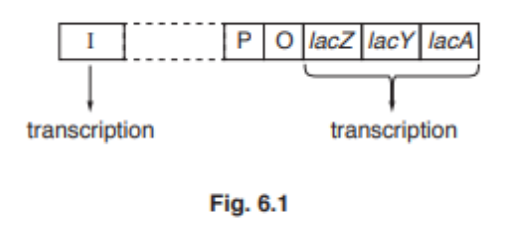
(i) Fig. 6.1 shows how the lac operon consists of structural genes and regulatory sequences.
Use Fig. 6.1 to identify two structural genes.
Complete Table 6.1 to name each structural gene and its product.[2]

(ii) Gene I is transcribed all the time to produce its protein. This is constitutive expression.
Explain why some genes show constitutive expression.[1]
(iii) Describe the effect of the product of gene I on the functioning of the lac operon.[2]
(b) If $E$. coli is put into a nutrient medium containing lactose, some new enzymes are synthesised. These are described as inducible enzymes.
(i) Explain what is meant by an inducible enzyme.[2]
(ii) The structural genes of the lac operon are not expressed when lactose is absent.
Suggest one reason why this is beneficial to $E$. coli.[1]
▶️Answer/Explanation
Ans:
6(a)(i) any two from [2]

6(a)(ii) gene products / enzyme/protein, needed all the time ;[1]
6(a)(iii) any two from
(repressor protein / gene product), binds to the operator ;
blocks promoter ;
RNA polymerase unable to bind to promoter ;
4 no, transcription / expression / activation / mRNA synthesis, of (named) structural genes ;[2]
6(b)(i) 1 only produced when, substrate / inducer / lactose, is present ;[2]
2 (substrate /inducer / lactose) causes gene expression/gene activation/transcription/mRNA synthesis ;
6(b)(ii) no waste of, amino acids / ATP / nucleotides / energy ;[1]
Question
(a) Fig. 7.1 is a transmission electron micrograph of part of a chloroplast of a leaf cell from maize.

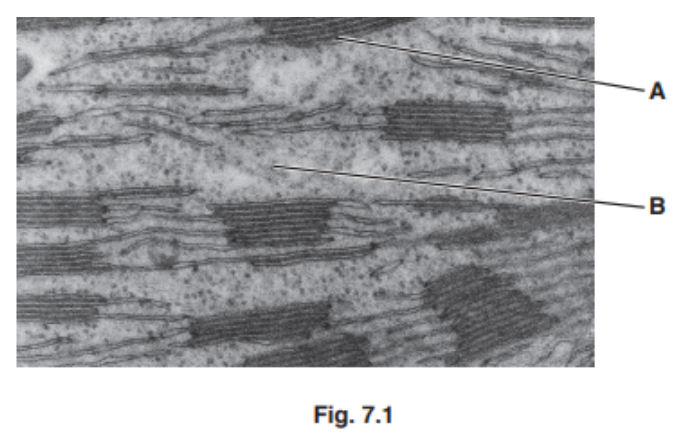
Table 7.1 shows some substrates and products involved in photosynthesis.
Use letter A or letter B from Fig. 7.1 to complete Table 7.1 to show the location where the substrates or products are used or produced.
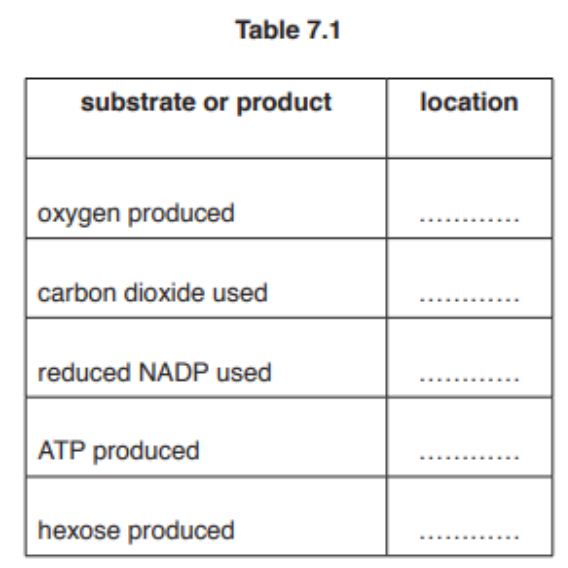 [3]
[3]
(b) Chloroplasts isolated from leaf palisade cells can still function if they are suspended in a buffer solution. The buffer solution has the same water potential as the chloroplasts.
The dye DCPIP is a hydrogen acceptor that changes colour from blue to colourless when it becomes reduced.
Three test tubes were set up as shown in Table 7.2 and left for 20 minutes to allow any colour change to occur. The results are also shown in Table 7.2.


(i) Explain the results for test-tube 2 . [2]
(ii) Test-tube 1 is a control tube. Explain why test-tube 1 was included in the investigation. [1]
(iii) Suggest and explain what would happen to the chloroplasts if they were suspended in distilled water.[2]
(c) The rate of photosynthesis in green plants can be limited by factors such as light intensity, temperature and carbon dioxide concentration.
State which factor would have no effect on the reducing ability of a chloroplast suspension. Give a reason for your answer.[2]
factor………………………………………………………..
reason………………………………………………………….
▶️Answer/Explanation
Ans:
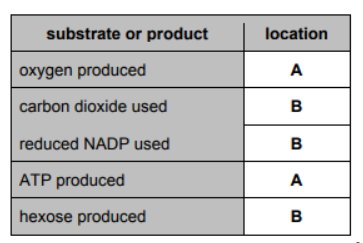
$\begin{aligned} & 5 \text { correct }=3 \text { marks } \\ & 3 \text { or } 4 \text { correct }=2 \text { marks } \\ & 1 \text { or } 2 \text { correct }=1 \text { mark }\end{aligned}$
7(b)(i) two from:[2]
1 light dependent reaction / photophosphorylation / photolysis occurred ;
2 hydrogen, produced/released; $\mathrm{R} \mathrm{H}^{+}$
3 DCPIP reduced;
7(b)(ii) one from:[1]
to show that any change in colour is, due to chloroplasts / not due to buffer ; to make (the experiment) valid / to act as reference point ;
7 (b)(iii) two from:[2]
1 swell / burst/ lyse / lysis ;
higher water potential outside chloroplast ; ora
water enters, by osmosis / down water potential gradient ;
7 (c) $\quad$ carbon dioxide concentration ;[2]
not involved in, light dependent reaction/photophosphorylation / photolysis or
only involved in light independent reaction / Calvin Cycle/ ora ;
Question
(a) Homeostasis in mammals involves negative feedback mechanisms. Outline how a negative feedback mechanism works.
(b) Fig. 8.1 is a diagram summarising the role of the nervous and endocrine systems in the control of blood glucose concentration.[4]
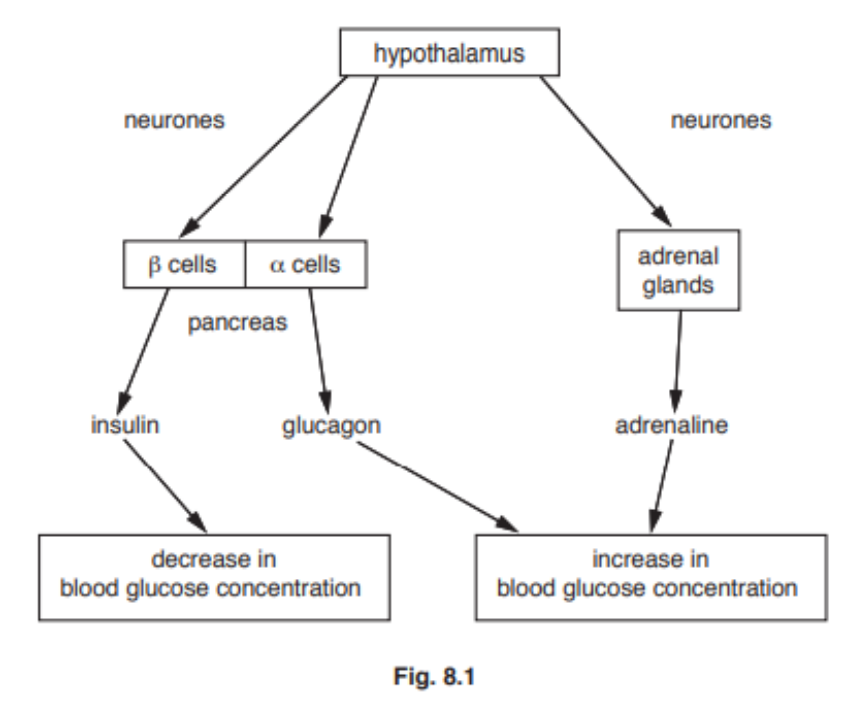
With reference to Fig. 8.1, describe the role of the nervous system in the control of blood glucose concentration.[4]
(c) If the core temperature of the human body falls, the hypothalamus sends impulses to activate several physiological responses, some of which are listed below.
For each one, state how it would help to bring the core temperature back to normal.
shivering
increasing secretion of adrenaline
vasoconstriction[4]
▶️Answer/Explanation
Ans:
8(a) four from:[4]
1 change in factor away from, the norm/ set-point ;
2 detected/ sensed by, receptor ;
3 hormone released or (nerve) impulse sent ;
4 (hormone / impulse) reaches, target organ / effector ;
5 (effector) performs corrective action ;
6 (factor) returns to, norm / set-point ;
8(b) four from:[4]
1 hypothalamus detects change in blood glucose concentration ;
2 autonomic/motor/nerve, impulses ;
3 (so) $\beta$ cells secrete insulin when blood glucose increases ;
4 (so) $\alpha$ cells secrete glucagon when blood glucose decreases ;
5 (so) adrenal gland secretes adrenaline either when blood glucose decreases or due to fear/shock/excitement/ stress ;
6 nervous control supplements, endocrine control/ control by pancreas ;
8(c) four from:
vasoconstriction [4]
1 arterioles in skin get narrow(er);
2 less blood flow through (skin / surface) capillaries ;
3 (so) less heat lost (to surroundings);
shivering
4 muscle contraction;
5 releases/provides/ gives, heat/ thermal energy ;
increasing secretion of adrenaline
6 increases, rate of respiration/metabolic rate ;
7 more heat, released / provided / given (by respiration);
Question 9
(a) Explain how dip sticks function to test for glucose in a sample of urine.$[8]$
(b) Outline how a high blood glucose concentration returns to normal in a healthy person. [7] [Total: 15]
▶️Answer/Explanation
Ans:
9(a) $\max 8$ of:[8]
1 stick has, pad containing / immobilised, enzymes ;
2 glucose oxidase ;
3 peroxidase ;
4 stick dipped in urine ; A person, urinates / AW, on stick
5 glucose reacts to give hydrogen peroxide ;
6 (hydrogen peroxide reacts with) colourless substance / chromogen ; $\mathbf{R}$ dye / pigment
7 to give, colour change / coloured substance ; A change to any named colour
8 compare with colour chart ;
9 more glucose gives darker colour ;
10 specific/only detects glucose ;
11 AVP ; e.g. does not give current blood glucose concentration not numerical
9(b) $\quad \max 7$ of:[7]
high blood glucose concentration
1 detected by $\beta$ cells; $\mathbf{I}$ alpha cells $\mathbf{I}$ receptors
2 in, islets of Langerhans / pancreas ;
3 (more) insulin secreted; $\mathbf{I}$ produced
4 into blood ;
5 increases glucose absorption in liver (by phosphorylating glucose) ;
6 increases permeability to glucose in, muscle / fat, cells or adds GLUT 4 proteins to cell surface membranes of, muscle / fat, cells ;
7 increases (rate of) respiration of glucose ;
8 conversion of glucose to glycogen / glycogenesis;
9 inhibits secretion of glucagon/decreases gluconeogenesis ;
10 negative feedback;
Question 10
(a) Describe the response of the Venus fly trap to touch.[8]
(b) Explain the control of gibberellin synthesis and outline how gibberellin stimulates stem elongation.[7]
▶️Answer/Explanation
Ans:
10(a) eight from
1 mechanical energy converted to electrical ;
ref. to sensory hair cell (is receptor/detects touch);
cell membrane depolarises ;
(if at least) two hairs touched (within 35 seconds);
action potential occurs ;
action potential/depolarisation, spreads over, leaf/lobe ;
ref. to hinge/midrib, cells ;
$\mathrm{H}^{+}$, pumped out of cells/pumped into cell walls ;
cell wall, loosens/cross-links broken ;
10 calcium pectate dissolves (in middle lamella);
$11 \mathrm{Ca}^{2 *}$ (ions) enter cells ;
12 water, enters/follows, by osmosis;
13 cells, expand/become turgid ;
14 change from convex to concave;
15 trap shuts. quickly/in $<1 \mathrm{~s} /$ in $0.3 \mathrm{~s}$;
16 AVP; acid growth hypothesis/expansins/elastic tension;
10(b) seven from
control
1 gibberellin synthesis/dwarfism, controlled by gene Le/le ;
2 dominant allele/Le, gives, functional enzyme/active gibberellin ; ora
3 enzyme converts inactive to active gibberellin ;
stem elongation
4 without GA, transcription factor/PIF, attached to DELLA protein ;
5 GA binds to receptor (complex) ;
6 causes DELLA (protein) destruction ;
7 transcription factor/PIF/RNA polymerase, binds to DNA;
8 (growth) genes, switched on/expressed/transcribed ;
9 causes cell division ;
10 causes cell elongation ;
11 increases internode length ;
12 loosens cell walls/acid growth;
13 so cells can expand when water enters ;
14 AVP ; e.g. interaction with auxin, ref. to expansins
Other Questions also part of this guess paper.
Question 11
(a) The golden mantella, Mantella aurantiaca, is a small terrestrial frog found in Madagascar.
Fig. 1.1 shows a golden mantella.

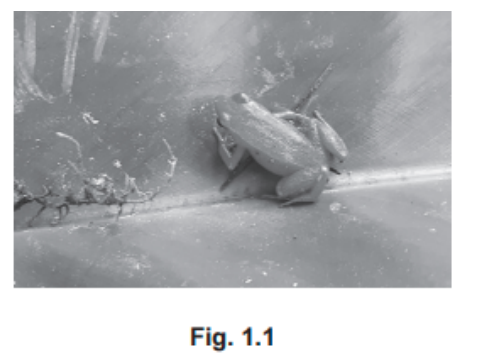
(i) Name the domain and kingdom to which the golden mantella belongs.
domain
kingdom [2]
(ii) The skin of the golden mantella is brightly coloured and contains a toxin.
Suggest a benefit to the frog of being brightly coloured.[1]
(b) The toxin in the skin of the golden mantella affects the action of the sarcomeres in muscle fibres (muscle cells) of mammalian striated muscle. The toxin inhibits a protein, $\mathrm{Ca}^{2+} \mathrm{ATPase}$, found in the membrane of the sarcoplasmic reticulum.
$\mathrm{Ca}^{2+}$ ATPase pumps calcium ions from the cytoplasm into the sarcoplasmic reticulum when the fibre is no longer stimulated.
Suggest the consequences to the sarcomere of the action of the golden mantella toxin.[3]
(c) Describe the role of calcium ions in a cholinergic synapse.
Question 12 (Reference : M 2022 – QP 42 – Q4)
(a) Meiosis is an important process that contributes to genetic variation in a population.
Fig. 4.1 shows a pair of homologous chromosomes during prophase I of meiosis.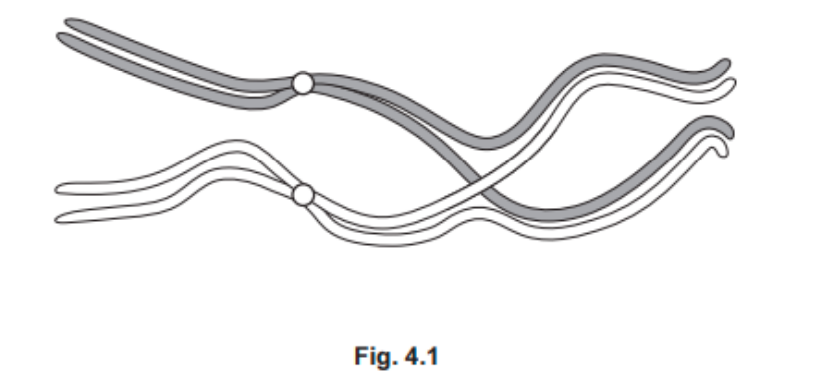
(i) On Fig. 4.1, use the letter $\mathrm{C}$ with a label line to identify where crossing over occurs. [1]
(ii) Describe how crossing over produces genetic variation in a population.
(b) Wing pattern in the butterfly species Heliconius melpomene is controlled by genes on autosomal chromosomes.
The gene for banding pattern on the upper wing has two alleles:
- a dominant allele coding for a full band
- a recessive allele coding for a broken band.
The gene for ray pattern on the lower wing has two alleles:
- a dominant allele coding for rays
- a recessive allele coding for no rays.
Scientists crossed a butterfly that was homozygous dominant for both genes with a butterfly that was homozygous recessive for both genes. The scientists wanted to check whether the phenotypic ratio for offspring in the F2 generation agreed with the expected phenotypic ratio of $9: 3: 3: 1$.
The results of this genetic cross are shown in Fig. 4.2.
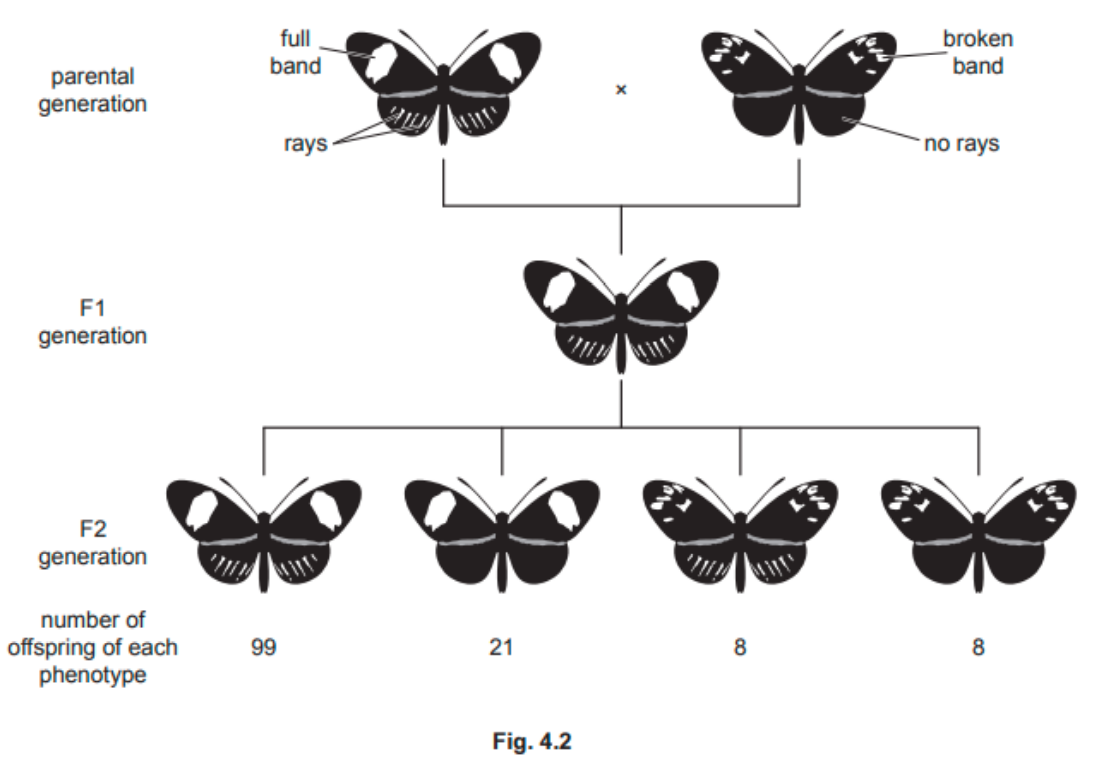
(i) Explain the term F1 generation.
(ii) The scientists used the chi-squared $\left(\chi^2\right)$ test to compare their data to the expected phenotypic ratio of $9: 3: 3: 1$. The formula for the chi-squared test is shown in Fig. 4.3.
$
\begin{array}{ll}
\chi^2=\Sigma \frac{(O-E)^2}{E} \text { key to symbols } \\
O=\text { observed value } \\
E =\text { expected value }
\end{array}
$
Fig. 4.3
Complete Table 4.1 and use the chi-squared formula in Fig. 4.3 to calculate the $\chi^2$ value for these data.
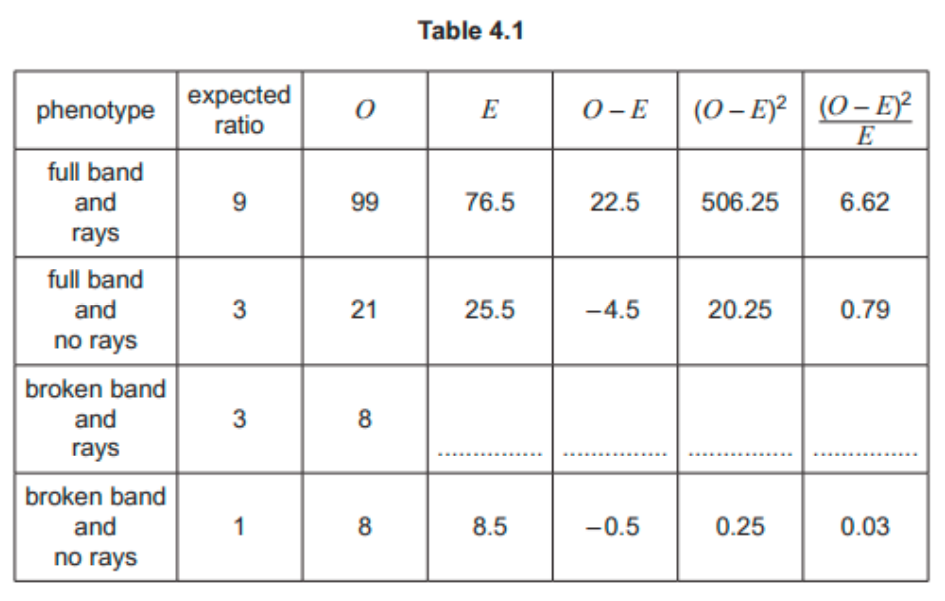
(iii) The critical value at the 0.05 probability level and three degrees of freedom is 7.81 .
Using the result of your calculation in (b)(ii), explain whether the results of the study agree with the expected ratio of phenotypes for the F2 generation.[3]
(iv) Suggest two reasons why phenotypic ratios in the F2 generation do not always match the expected ratios.[3]
Question 13 (Reference : M 2021 – QP 42 – Q3)
Vitamin A deficiency is a widespread public health problem.
One source of vitamin A is carotene in the diet. Carotene can be converted to vitamin A in the body.
White rice grains are not a dietary source of vitamin A because they do not contain carotene.
Scientists have genetically modified a variety of rice to improve the diet of people who are vitamin $\mathrm{A}$ deficient. The grains of this genetically modified rice contain carotene.
(a) Describe how genetic engineering could be used to modify a variety of rice so that the grains contain carotene.[4]
In a 2018 report, the United Nations Children’s Fund (UNICEF) estimated that:
- more than 140 million children are at high risk of vitamin A deficiency
- 1.15 million child deaths are caused by vitamin A deficiency each year.
Vitamin A deficiency is also a leading cause of childhood blindness.
The recommended dietary allowance (RDA) of vitamin A for a 5-year-old child is $400 \mu \mathrm{g}$ per day.
Genetically modified (GM) rice contains $12 \mu \mathrm{g}$ of carotene per gram of rice. In 2018 , four countries approved $\mathrm{GM}$ rice as safe to eat.
The development of GM rice has been partly paid for by governments. It has been agreed that seeds of GM rice will be made available to farmers in countries with high levels of poverty at the same cost as seeds of normal rice.
Some international organisations, such as Greenpeace, campaign against all GM crops.
More than 100 respected scientists have asked Greenpeace to stop campaigning against GM rice.
(b) Discuss social and ethical arguments that support the position of the scientists.